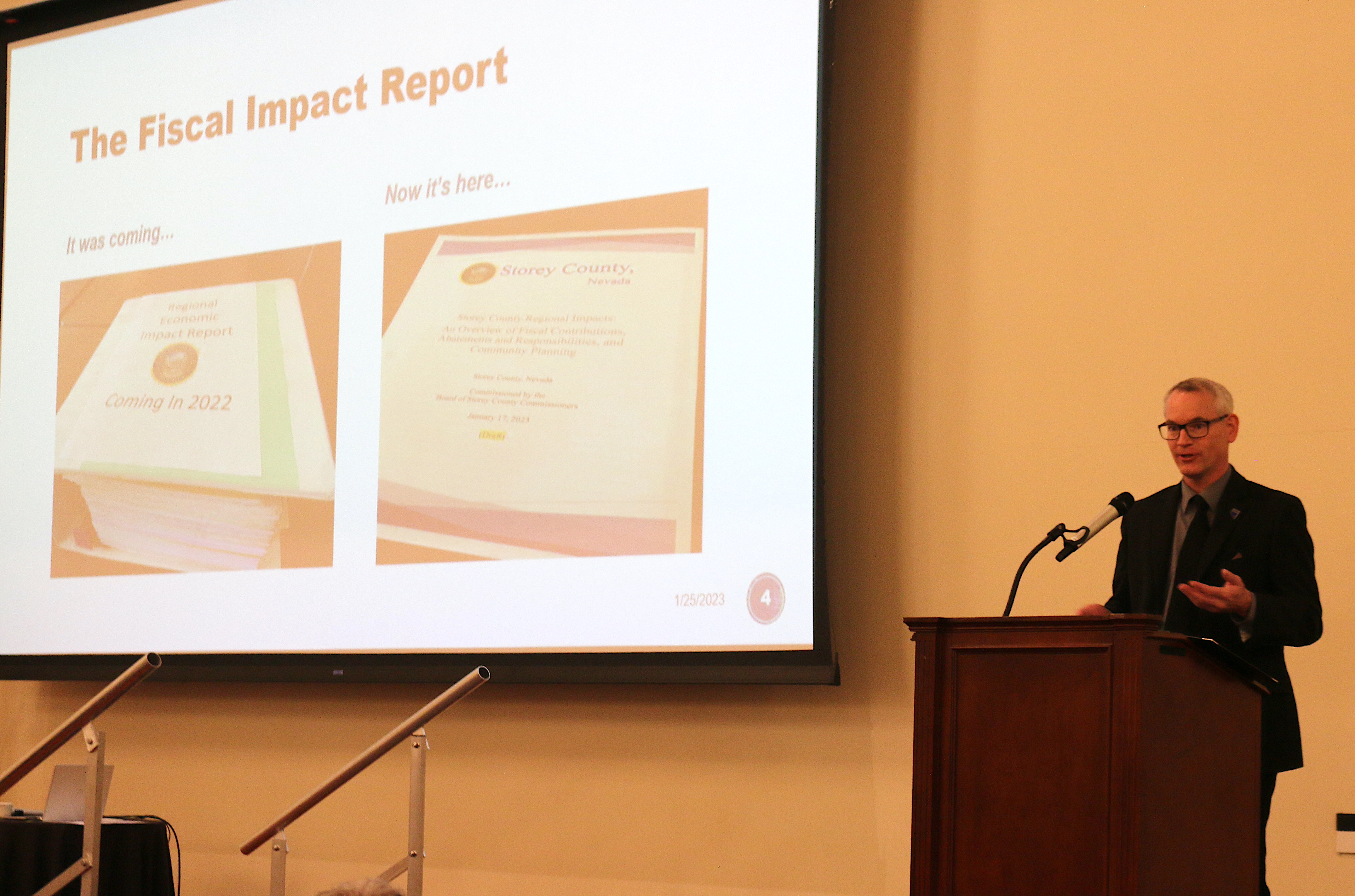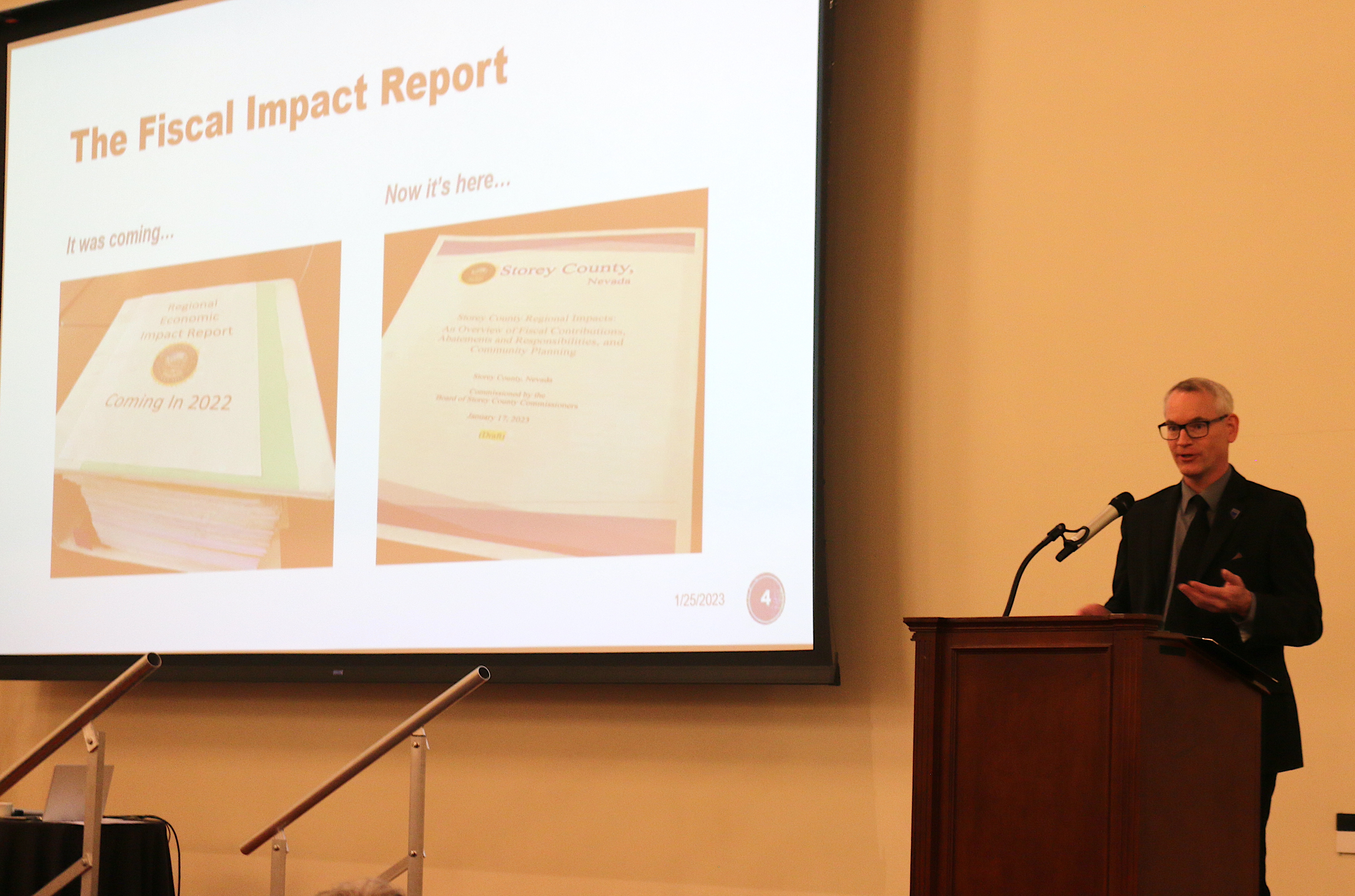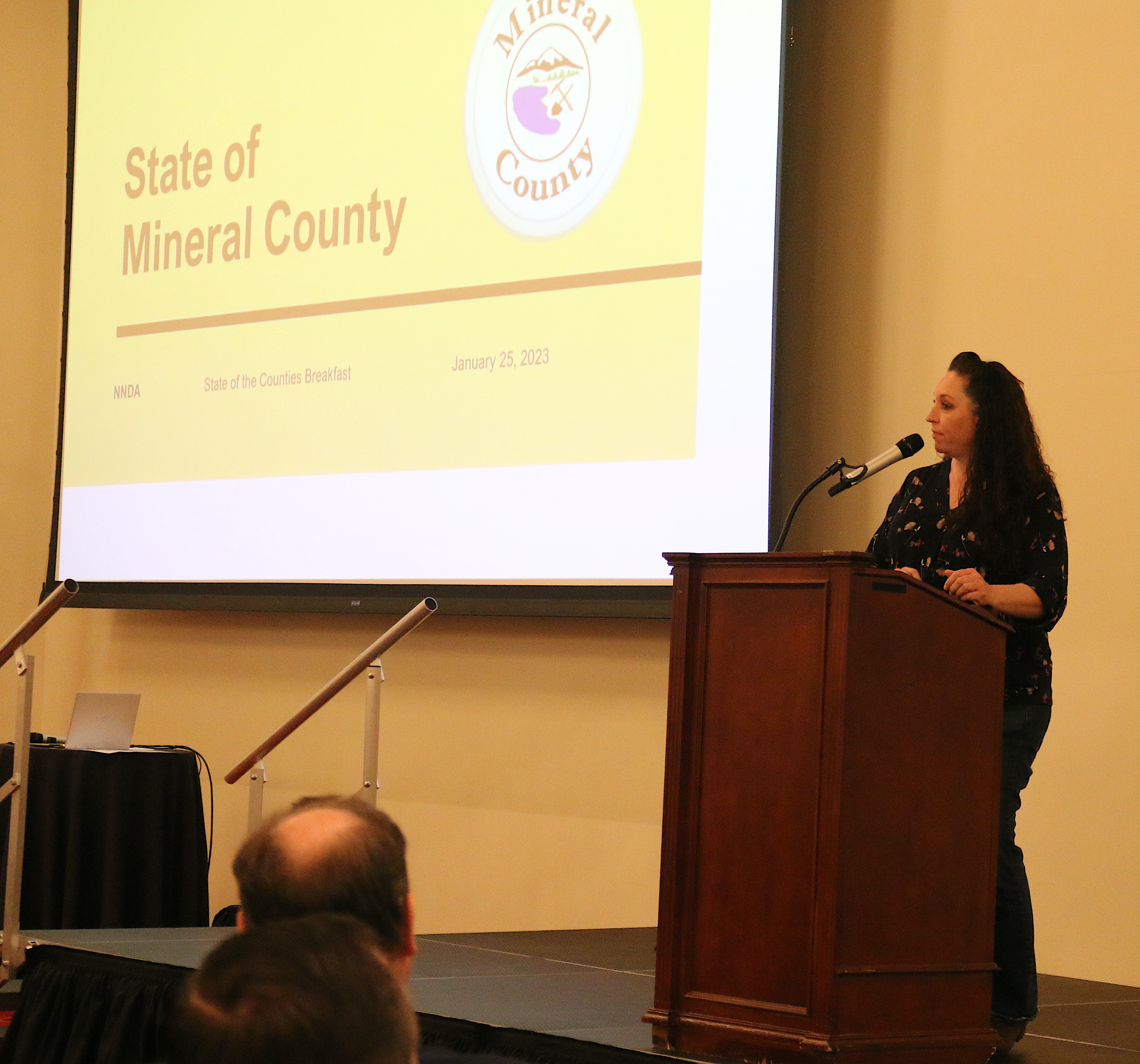Carson City Manager Nancy Paulson provides an update on Carson City at the Northern Nevada Development Authority’s annual “State of the Counties” event Wednesday. Photo by Jessica Garcia.
Community development, capital improvements and essential dollars to fund social services from tax revenue continue to serve as common threads between neighbors Carson City, Douglas, Lyon, Storey and Mineral counties.
The Northern Nevada Development Authority welcomed back returning four of its returning speakers – Carson City Manager Nancy Paulson, Douglas County Manager Patrick Cates, Mineral County Commission Chair Cassie Hall and Storey County Manager Austin Osborne. NNDA also welcomed new Lyon County Manager Andrew Haskin.
Carson City’s conservative budget
Carson City Manager Nancy Paulson said the city continues to plan for its future by focusing on critical infrastructure projects and deferred maintenance, building up reserves and budgeting conservatively.
In 2022, the general fund balance came in higher than anticipated at $20.4 million, or approximately $7.4 million more than city officials thought with revenues generated at about $2 million due likely to unfilled vacant positions, she said.
Paulson noted overall the fund balance did drop from fiscal 2021 from $26 million but said “there’s no need to panic yet” with the city’s reserves intact for now. The prior year’s sales tax increases made an impact, she said.
She said Carson City’s priority to remain financially strong in 2023 is to maintain adequate levels of funding and increase its bond rating. She said generally the public doesn’t like to hear the city budgets conservatively, but the higher its bond rating, the lower an interest rate it maintains.
Douglas County’s opportunities
Douglas County Manager Patrick Cates reported the area has seen a 5.3% growth since 2010, with a faster aging population older than 65 of 26.4% that exceeds the national average of 15.2%. Those who are retired or will retire soon make up about 38.7% of Douglas’ population, which fares against the nation’s 22.3%.
In fiscal year 2021-22, Cates said property taxes remained the county’s largest source of revenue at 38%, with 21% of funding through intergovernmental shared revenues, 20% through room taxes and the rest through capital or operating grants or sales taxes.
“One of my goals is to increase the amount of federal funds we bring into the county,” he said, referring to projects such as the Carson Valley Medical Center, a 54,000-square-foot expansion now in progress, to assist the older population that might rely on such dollars to expand medical services and capital improvement opportunities.
Cates also referred to the Barton Health regional expansion at Stateline, transforming the former Lakeside Inn and Casino into a new hospital. He also said the American AVK Co. expansion for which the Nevada Governor’s Office of Economic Development has approved approximately $1 million in tax abatements in December would supply about 60 jobs for this 130,000-square-foot casting factory. The project would be operational in late spring 2024.
Cates said the Tahoe Blue Center, a planned 5,500 seat arena, is planned to open in July and will offer visitors meeting room and convention space as well as job opportunities.
Cates shared he was excited about the Muller Parkway project, a collector road between South Gardnerville and North Minden to help ease congesting on the U.S. 395 with the groundbreaking scheduled for later this year, as well as the Art in Public Places project.

Jessica Garcia / Nevada Appeal
Lyon County Manager Andrew Haskin provides a fiscal update on Lyon County at the Northern Nevada Development Authority’s annual “State of the Counties” event Wednesday.
Lyon County’s capital improvements
The NNDA welcomed Haskin, who announced the county commission approved his contract at its Jan. 19 meeting.
Haskin announced Lyon’s total revenues for fiscal year 2022 have dipped slightly to $42.5 million from $43.6 million in 2021. Expenses, covering general government, public safety, judicial, health and recreational costs, have increased in the same year from $37.5 million to $40.2 million due to capital projects. The county’s ending fund balance for 2022 was about $10.7 million.
Haskin reviewed some of Lyon’s ongoing projects, including the Aspen Creek Rapid Infiltration Basins, which will build a 1.4-million-gallon-per-day rapid infiltration basin and upgrades to the current Rolling A pump station. He described the 10 Mile Hill Water Tank to be developed with a road across from U.S. 50 as well as a second 300-foot bridge that was identified for the east end of Dayton Valley to connect to Chaves Road. The bridge will provide right of way through Bureau of Land Management property and other developments, and the county currently is seeking funding opportunities for design and construction, Haskin said.
He also discussed updating the county’s area drainage master plans to ensure its guidelines are in alignment with current maps and flow data for developers. Lyon is working with new two drainage area master plans and with Caron Water Subconservancy District for Stagecoach and North Silver Springs, he said.
“The improvements to the plans suggested are very expensive so it’s going to take us a long time to build and work through mitigation efforts, but at least having it planned allows us to build that indoor capital improvement plan and plan for the future,” he said.
Building permits for single-family residential permits have increased year over year from 2022, he said, and although they are not available for January, he said they are likely to show the same.
Lyon has seen new development in the past year, including the expansion of the distribution center Webstaurant in Dayton, a growth of about 620,000 square feet added to its previous 350,000 square feet. The Traditions master planned community, owned by DR Horton, has applied for or received 44 residential building permits, with site improvements to be made on Phase 2, a total of 65 lots. Haskin said the developer plans to begin work on Phase 3, a total of 61 lots, soon.
Also, Haskin said work is happening on the Northern Nevada Industrial Center at USA Parkway, with grading underway upon 750,000 square feet of space.

Jessica Garcia / Nevada Appeal
Storey County Manager Austin Osborne provides a fiscal update on Storey County at the Northern Nevada Development Authority’s annual “State of the Counties” event Wednesday.
Storey County’s TRIC keeps on giving
Storey County’s approximate $25 million budget, which, county manager Austin Osborne said, surprises many who think the number is greater with the region’s ongoing economic development, focuses largely on its lasting success to date with the Tahoe Regional Industrial Center. The agreement is with developer Roger Norman who laid the infrastructure and is in a 50-year agreement with the county. In 2022, Storey paid $3.8 million of its expenses to Norman for TRIC payback, and that payback will be a recurring theme for now.
Osborne said Storey continues to lead the state in tax abatements, having $1 billion more than Clark and about $1.2 billion more than Washoe.
But he addressed the challenges with Senate Bill 1, the tax break bill signed by former Gov. Brian Sandoval in 2014 providing Tesla about $1.25 billion in tax abatements for its $3.5 billion in investments in the span of 10 years. The legislation passed the Senate 21-0.
Osborne said through SB1, Tesla pays Storey to defray $6.5 million in general costs between 2021 to 2024 and $2.7 million in roads for the same period, and he cautioned counties to be prepared if they consider similar arrangements.
In Storey’s move from “effluent to affluence,” Osborne addressed the importance of regional cooperation in turning its effluent pipeline into a regional economic generator.
Manufacturing jobs also are up by 55% in Storey, thanks to the Gigafactory, and average wages are above the state in general, with construction, information technology and science technology all sitting comfortably higher than Nevada.
Osborne said Storey’s capital improvement plan for 2023 will cost about $9 million, a piece of a total $600 million over 10 years, to help address critical projects that include water transmission and distribution needs, the Gold Hill sewer lines, bring two more fire stations to TRIC, build or plan for sheriff and court facilities, replace the 1964 swimming pool, assist with road rehabilitation and provide a senior or community center.

Jessica Garcia / Nevada Appeal
Mineral County Commissioner Cassie Hall provides an update on Mineral County at the Northern Nevada Development Authority’s annual “State of the Counties” event Wednesday.
Mineral County’s progress
Although the county has not yet hired a county manager and was unable to provide specific data for this year’s presentation, Mineral County Commissioner Cassie Hall said the region has made strides through consolidation and achieving its goals by combining its room tax and tourism departments into a recreation and community development department because it is short in human resources, she said.
However, the director has been able to advance recreational needs such as saving the local golf course, negotiate water rights and regenerate local favorite activities such as pickleball and disc golf and continue with important community development concepts that are essential to Mineral’s experiences and beginning conversations among residents.
Hall said another success has been to hire a grant administrator to help identify and secure American Recovery Plan Act, Local Assistance and Tribal Consistency Fund and Community Development Block Grant opportunities
Hall said the planning commission is working with the Northern Nevada Development Authority and Converse Consultants for a master plan and rezoning and hopes to follow the model of the TRIC in its development. Although she said it’s not likely to reach TRIC’s size, “I do think we have a beautiful model to follow,” Hall said.
Last year, COVID-19 made the county aware of testing and vaccination challenges, and Mineral is seeking to improve its public health preparedness. Hall said the county partnered with Churchill County and created the Central Nevada Health District to assist with disease investigation, public health nursing, environmental health and disease prevention.
Hall said there are other mental health and social services projects she hopes to announce in the future.
She also referred to updates on the Luning Solar Plant expansion, the potential for ARPA wage increases and progress with the county’s building department in property improvement and in addressing the local housing crisis.